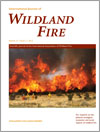
International Journal of Wildland Fire
Volume 21 Number 2 2012
WF11001 Interdependencies between flame length and fireline intensity in predicting crown fire initiation and crown scorch height
This paper constitutes a comprehensive review of the pitfalls associated with the inter-relationships among four widely used descriptors of surface fire behaviour and post-fire impacts in wildland fire science and management, namely fireline intensity, flame length, stem-bark char height and crown scorch height.
WF10121 Wildfire activity in rainforests in western Patagonia linked to the Southern Annular Mode
In the context of current and future warming conditions, predictions of fire activity in temperate rainforests forecast an increase in fire frequency and severity. This study uses tree-ring fire history records and reconstructed regional climate modes to examine past fire–climate relationships in temperate rainforests in western Patagonia.
WF10034 Entrainment regimes and flame characteristics of wildland fires
The flame model of Albini (1981, Combustion and Flame, doi:10.1016/0010-2180(81)90014-6) is used as a starting point for developing flame height and tilt angle models for wind-aided fires. Entrainment parameters are estimated using data from 54 fires burned in laboratory and field settings. Flame heights and air/fuel mass ratios are similar for wind-tunnel and field fires, but flame tilt angle relationships differ.
WF10133 Spatial and temporal drivers of wildfire occurrence in the context of rural development in northern Wisconsin, USA
Spatial point pattern analysis was used to quantify the spatial pattern of wildfire occurrences, and linear regression models were used to quantify the drought influence and temporal trends in annual number of wildfires and mean fire size from 1985 to 2007 in northern Wisconsin, USA.
WF10050 Effects of hydromulch on post-fire erosion and plant recovery in chaparral shrublands of southern California
Hydromulch effectiveness was compared at 50 and 100% treatments following the Cedar Fire. All treatments were effective in reducing erosion during the first winter; however, hydromulch broke down rapidly the first year, contributing to elevated sediment during heavy autumn rains. Growth of chamise and forbs was enhanced on hydromulch sites.
WF10066 Evaluating regression model estimates of canopy fuel stratum characteristics in four crown fire-prone fuel types in western North America
Two separate evaluations were undertaken of previously published regression equations used for predicting canopy base height, canopy fuel load and canopy bulk density from stand structure variables for four conifer forest types found in western North America. The first involved the application to simulating the effects of thinning. The second consisted of a direct comparison against an independent dataset. Considering their simplicity, the stand-level models for estimating canopy fuel stratum characteristics were found to be quite robust.
WF11015 A comparison of two methods for estimating conifer live foliar moisture content
Moisture content is a key factor in determining the ignition and spread of fires in live fuels. Rapid moisture analysers and oven-drying are commonly used to determine the live foliar moisture content but these two methods have never been compared. This paper shows that the two methods produce nearly identical measurements of moisture content over an entire growing season for a common conifer species.



